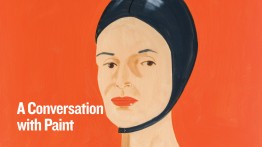COOPERMADE Alex Katz: A Conversation with Paint
POSTED ON: January 27, 2023

Alex Katz Bathing Cap (Ada), 2010 © Alex Katz / Licensed by VAGA at Artists Rights Society (ARS), NY
Since October, the work of the artist Alex Katz has been the subject of a career retrospective at the Guggenheim Museum entitled Alex Katz: Gathering. A 1949 graduate of the School of Art, Katz’s work unfurls through the museum’s famous rotunda, which is arranged chronologically to highlight the artist’s position as a painter who, while never part of any one mid-century art movement, absorbed their lessons to create a singular body of work.
Katz, who was born in Brooklyn and raised in St. Albans, Queens, grew up with a family dedicated to the arts. His mother, Sima, had been an actress in the Yiddish theater, going by the name Ella Marion; his father loved poetry. Both were immigrants from Russia. The family was, by the lights of the era an eccentric one, painting and repainting rooms in their house in striking color combinations. At one point, in an attempt at “normalcy,” Katz took it upon himself to paint his own room beige with brown trim.
At Cooper, Katz studied under Morris Kantor, a painter who explored multiple genres of painting, including Cubism and Realism. He taught Katz to paint from drawing, a method the younger artist employed until experiencing the work of Jackson Pollock. But before then the young artist sharpened his drafting chops while commuting to school from Queens by drawing scenes on the subway, some of which are included in the Guggenheim exhibition. As the photographer Jill Krementz sees it, the subway provided Katz a wide range of people to sketch where “he was fascinated by the theater of the transient crowd.” (Years later, the MTA returned the compliment by mounting his work in the 57th Street station on the N line. And his own face has become a familiar presence for East side commuters since 2017, when Chuck Close’s portrait of Katz became part of the new 96th street station at Second Avenue.)
After graduation, Katz received a scholarship to attend Skowhegan School for Painting and Sculpture in Maine. He was immediately taken with the region’s landscape, which has been a source of inspiration throughout his career and has sometimes provided the muted backgrounds for his portraits. It was at Skowhegan that Katz began painting from life without intermediary drawings. It was a turning point for the painter who always used the human figure as the medium for his painting experiments. During the 1950s, when abstract expressionism dominated the art world, he struggled to find a way to paint what he saw but, as he put it, “bring it into modern art.”
In 1958, Katz married Ada del Moro, a Bronx native who worked as a research biologist. A central figure in his oeuvre, she is unflappable and intriguing, appearing in stylish hats, scarves, and even bathing caps. Perhaps best known among his Ada paintings is Katz’s 1960 painting “The Black Dress” in which six versions of Ada can be seen at a gallery opening wear the ne plus ultra of cocktail dress. In 2006, the writer Leslie Camhi described Ada in the painting: “Her aura is at once understated and utterly constant, like the idea of God or the weather.” In fact, the Jewish Museum once organized a show of the Ada canvases entitled Alex Katz Paints Ada.
Over the years, Katz has varied both the size and materials he uses. In the 1960s, he started painting some of his work on shaped aluminum sheets—he continues to use these sculptural “canvases” today. At the same time, inspired by the boldness of film, television, and billboards, he began to work on a large scale with close-up, filmic faces filling his canvases. As visitors work their way up the Guggenheim ramp, they’ll witness these techniques applied to landscape paintings and, most recently, work resulting from collages he’s made from iPhone pictures then translated to oil paint on linen. With this latest work on view, the exhibition shows Katz in conversation with more than 70 years of ideas in American art.




